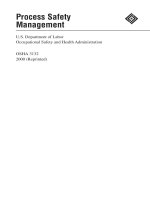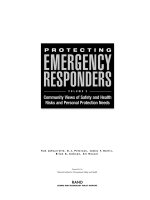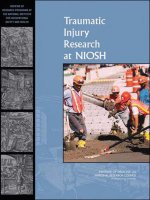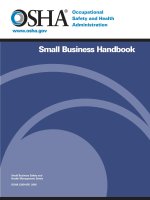Institute of occupational safety and health
Bạn đang xem bản rút gọn của tài liệu. Xem và tải ngay bản đầy đủ của tài liệu tại đây (1.12 MB, 35 trang )
Institute of Occupational Safety and Health
Safety Training
Presentations
Asbestos Safety Awareness
FY-11 OSHA Susan Harwood
Grant Program
This material was produced under grant
number SH22297-SH1 from OSHA. It does
not necessarily reflect the views or policies of
the U.S. Department of Labor, nor does
mention of trade names, commercial products,
or organizations imply endorsement by the
U.S. Government.
Objectives: Participants will:
• Define what is asbestos
• Describe where asbestos is found
• Explain associated health hazards
• Illustrate how to protect yourself and co-workers
against asbestos hazards
• Analyze and discuss case studies
What is Asbestos?
•The word "asbestos" comes from the Greek meaning
"inextinguishable."
•Asbestos is a serious health hazard commonly found
in our environment today.
• Employees who may work in buildings that contain
asbestos should know where it is found and how to
avoid exposure.
Asbestos History
• Many people believed asbestos a "miracle" product of the 20th
century…. That couldn't be further from the truth.
• 1st Century AD Pliny the Elder notes that slaves working in
asbestos mines die young of lung disease.
• The Greeks recognized that not everything about asbestos was
good.
• Greek and Roman scientists recognized asbestos caused
"sickness of the lungs" in the slaves that wove asbestos into
cloth or mined the mineral.
• Egyptian mummy’s were wrapped in asbestos containing
fabric
Asbestos Fibrous Minerals
Serpentine
Amphibole
(93% of commercial use)
(7% of commercial use)
Chrysotile
Actinolite, Amosite,
Anthophyllite,
Crocidolite, Richterite,
Tremolite
Six Types of Asbestos
Asbestos is composed of six different types of
natural minerals:
• Chrysotile
• Amosite
Most common types
• Crocidolite
• Tremolite
• Actinolite
• Anthophyllite
Asbestos Fiber Facts
• All types of asbestos tend to
break into very tiny fibers.
• These individual fibers are so
small they must be identified using
a microscope.
• Some fibers may be up to 700
times smaller than a human hair.
Asbestos Fiber Facts
Because asbestos fibers
are so small, once
released into the air,
they may stay
suspended there for
hours or even days.
Asbestos Facts
• Asbestos fibers are also virtually indestructible.
• Resistant to chemicals and heat, and they are
very stable in the environment.
• Do not evaporate into air or dissolve in water,
and they are not broken down over time.
• Asbestos is probably the best insulator known
to man.
Asbestos Facts
Usually asbestos is mixed with other materials to
actually form the products. Floor tiles, for example, may
contain only a small percentage of asbestos.
Depending on what the
product is, the amount
of asbestos in asbestos
containing materials (ACM)
may vary from 1%-100%.
Asbestos Exposure
1.3 million workers are exposed in the U.S. –
primarily in the construction industry.
Asbestos removal and building renovation &
demolition have the greatest exposures.
Exposure in general industry:
- manufacture of asbestos
products
- automotive brake and clutch
repair
- Housekeeping and custodial
work
Where is Asbestos Found?
•
•
•
•
Adhesives, Cements, Mortar, Sealers
Millboard
Brake linings and clutch pads
Let’s talk about vermiculite!
Vermiculite
• A mine near Libby, Montana sold 70% of all
vermiculite in the U.S. from 1919 to 1990.
• There was a sediment of asbestos at that mine, so the
vermiculite from Libby was contaminated with
asbestos.
• Libby vermiculite was used in the majority of
vermiculite insulation in the U.S. as the brand name
“Zonolite”
Libby Montana DVD
You should assume that:
VERMICULITE CONTAINS ASBESTOS
AND DO NOT DISTURB IT!
/>
Always Assume Vermiculite
Contains Asbestos
• Leave vermiculite insulation undisturbed in your attic
or in your walls.
• Do not store items in your attic if it contains vermiculite
insulation.
• Do not attempt to remove the insulation yourself.
• Hire a licensed asbestos contractor remove or
encapsulate asbestos
More Asbestos Loaded Products???
• Cement Pipes, Cement Boards, Sheets, Plastics
• Clay, Compounds, Paints, Plasters
• Electrical, Mechanical Products
• Home Use Products
• Cigarette Filters
• Pipe Covering
• Protective clothing
Asbestos Occupations
Just to name a few:
• Plumbers
• Demolition
• Construction / remodeling
• Roofers
• Mechanics
• First Responders
/>tions/
Health Affects of Asbestos Exposure
• Asbestos exposure is the only confirmed
cause of mesothelioma, a fatal form of
cancer that typically manifests in the lungs
• Lung Cancer
• Asbestosis
Signs and Symptoms of asbestosis
can include:
• Shortness of breath is the primary symptom
• A persistent and productive cough (a cough that
expels mucus)
• Chest tightness
• Chest pain
• Loss of appetite
• A dry, crackling sound in the lungs while
inhaling.
Cigarette Smoke and Asbestos
• Cigarette smoke and asbestos together will increase
your chances of getting lung cancer.
• If you have been exposed to asbestos you should
stop smoking.
• This may be the most important action that you can
take to improve your health and decrease your risk
of cancer.
How to Protect Yourself
• Must have a valid and up to date certificate through
an authorized trainer from the State of Florida as an
Asbestos Worker, Supervisor, Contractor or
Inspector.
• Asbestos is dangerous…..sufficient education is needed
to recognize dangers and protect yourself
• You and the company could be fined if caught working
on a building that may contain asbestos
• Today’s training is an awareness course…DOES NOT
meet Florida law
How to Avoid Asbestos Exposure
• If you do not know that a building material is
asbestos free…….DOT DISTURB IT.
Never
Drill
Hammer
Cut
Saw
Break
Damage
Move
Disturb
How to Avoid Asbestos Exposure
• Personnel should understand how to protect
themselves
• In the event that asbestos fibers become airborne
and may be inhaled
• Wear a mask to prevent inhalation of asbestos fibers
• Safety gear such as gloves or booties that cover
your shoes should be worn, to prevent the spread of
asbestos fibers to other areas









